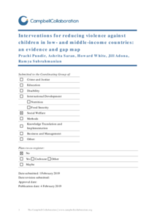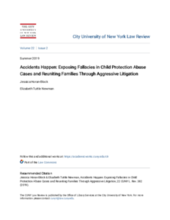Displaying 371 - 380 of 1087
In this paper, the authors advance a framework for examining the nature and consequences of neglect, which they posit can be represented as variations along a continuum from severe psychosocial neglect to environmental enrichment.
Guided by social-ecological theory, this study explores responses to violence against children with disabilities, including preventative measures and treatment of victims in the West African countries of Guinea, Niger, Sierra Leone, and Togo.
The primary aim of a recent qualitative study was to optimise grandparent-grandchild connectedness after child safety concerns.
The present investigation leveraged unstructured, case narrative fields in child welfare records to enhance knowledge about Child Protective Services (CPS) involvement among children born to mothers in care.
This study examined the impact of the model of professional childcare in a three-year project involving fifty-three children and young people and their carers in local-authority children’s homes on two UK areas (Northern and Southern England).
Out of the shadows: Shining light on the response to child sexual abuse and exploitation - a 40-country benchmarking index - examines how countries are responding to the threat of sexual violence against children.
This evidence and gap map will provide an overview of the existing systematic reviews and impact evaluations on the key outcome domains and interventions aimed at reducing violence against children in LMICs using an intervention-outcome framework.
The purpose of this study was to explore and describe the experiences of incarcerated women who had dumped or committed infanticide in Namibia.
The purpose of this article is to use the authors' experiences litigating physical abuse cases in the Bronx, New York City, USA to provide practitioners and family defenders both in New York and in other states with ideas and strategies of how to move cases forward for parents and caretakers charged with serious physical abuse of a child. It is our hope that, by challenging these allegations, defense attorneys can expose the misperceptions and overreach of agencies that charge parents with physical abuse based on injuries alone.
The objectives of the study are: 1) Identifying and classifying the level of child presence and the needs of children in the family and 2) implementation of integrated child protection models in families in integrated areas of West Timor.




